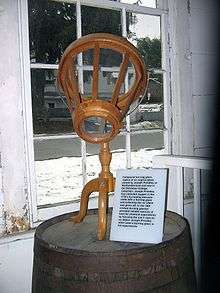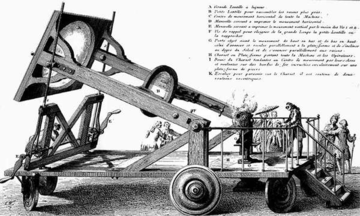Burning glass

A burning glass or burning lens is a large convex lens that can concentrate the sun's rays onto a small area, heating up the area and thus resulting in ignition of the exposed surface. Burning mirrors achieve a similar effect by using reflecting surfaces to focus the light. They were used in 18th-century chemical studies for burning materials in closed glass vessels where the products of combustion could be trapped for analysis. The burning glass was a useful contrivance in the days before electrical ignition was easily achieved.
History
The technology of the burning glass has been known since antiquity. Vases filled with water used to start fires were known in the ancient world. Burning lenses were used to cauterise wounds and to light sacred fires in temples. Plutarch refers to a burning mirror made of joined triangular metal mirrors installed at the temple of the Vestal Virgins. Aristophanes mentions the burning lens in his play The Clouds (424 BC).[1]
- "Strepsiades. Have you ever seen a beautiful, transparent stone at the druggists', with which you may kindle fire?"
The perpetual sacred fire in the classic temples as the Olympic torch had to be pure and to come directly from the gods. For this they used the sun's rays focused with mirrors or lenses and not impure triggers.
Archimedes, the renowned mathematician, was said to have used a burning glass (or more likely a large number of angled hexagonal mirrors) as a weapon in 212 BC, when Syracuse was besieged by Marcus Claudius Marcellus. The Roman fleet was supposedly incinerated, though eventually the city was taken and Archimedes was slain.[2]
The legend of Archimedes gave rise to a considerable amount of research on burning glasses and lenses until the late 17th century. Various researchers worked with burning glasses, including Anthemius of Tralles (6th century AD), Proclus (6th century) (who by this means purportedly destroyed the fleet of Vitalian besieging Constantinople), Ibn Sahl in his On Burning Mirrors and Lenses (10th century), Alhazen in his Book of Optics (1021),[3] Roger Bacon (13th century), Giambattista della Porta and his friends (16th century), Athanasius Kircher and Gaspar Schott (17th century), and the Comte de Buffon in 1740 in Paris.
The pop science TV program MythBusters attempted to model Archimedes' feat by using mirrors to ignite a small wooden boat covered with tar, with little success—they found it too difficult to focus light from their hand-held mirrors onto a point small enough to ignite the boat. However, an episode of Richard Hammond's Engineering Connections relating to the Keck Observatory (whose reflector glass is based on the Archimedes' Mirror) did successfully use a much smaller curved mirror to burn a wooden model, though not made of the same quality of materials as in the MythBusters effort.

Burning lenses were used both by Joseph Priestley and Antoine Lavoisier in their experiments to obtain oxides contained in closed vessels under high temperatures. These included carbon dioxide by burning diamond, and mercuric oxide by heating mercury. This type of experiment contributed to the discovery of "dephlogisticated air" by Priestley, which became better known as oxygen, following Lavoisier's investigations.[4]
In 1796, during the French Revolution and three years after the declaration of war between France and Great Britain, Étienne-Gaspard Robert met with the French government and proposed the use of mirrors to burn the invading ships of the British Royal Navy. They decided not to take up his proposal.[5]
Chapter 17 of William Bates' 1920 book Perfect Sight Without Glasses, in which the author argues that observation of the sun is beneficial to those with poor vision, includes a figure of somebody "Focussing the Rays of the Sun Upon the Eye of a Patient by Means of a Burning Glass."[6] Needless to say, this is highly dangerous and will damage the eye in seconds.
Current use
Burning glasses (often called fire lenses) are still used to light fires in outdoor and primitive settings.[7] Large burning lenses sometimes take the form of Fresnel lenses, similar to lighthouse lenses,[8] including those for use in solar furnaces.[9] Solar furnaces are used in industry to produce extremely high temperatures without the need for fuel or large supplies of electricity. They sometimes employ a large parabolic array of mirrors (some facilities are several storeys high) to focus light to a high intensity.
The Olympic torch that is carried around the host country of the Olympic Games is lit by a burning glass, at the site of ancient Olympia in Greece.[10]
See also
References
- ↑ http://classics.mit.edu/Aristophanes/clouds.html
- ↑ Meijer, Fik (1986), A History of Seafaring in the Classical World, Routledge, ISBN 978-0-7099-3565-0
- ↑ Roshdi Rashed (1990), "A Pioneer in Anaclastics: Ibn Sahl on Burning Mirrors and Lenses", Isis 81 (3), p. 464-491 [464-468].
- ↑ Joseph Priestley, Experiments and Observations on Different Kinds of Air Vol.2 (1776)
- ↑ Burns, Paul. "The History of The Discovery of Cinematography: Chapter Six 1750-1799". Accessed 29 July 2007.
- ↑ Bates, William H. (1920). "Chapter 17: Vision Under Adverse Conditions a Benefit to the Eye". Perfect Sight Without Glasses. New York: Central Fixation Publish Co. pp. 183–197. ISBN 88-900756-3-5.
- ↑ "Fire Glass". Primitivefire.com. Retrieved 2012-12-18.
- ↑ George A. Macbeth (1914). "Light House Lenses". Proceedings of the Engineers' Society of Western Pennsylvania. 30: 245.
- ↑ H. P. Garg, J. Prakash (2000). Solar Energy: Fundamentals and Applications. Tata McGraw-Hill Education. p. 305. ISBN 9780074636312.
- ↑ "Olympic Torch Relay history". London 2012 Olympic Games. Retrieved 27 November 2012.
Further reading
- Temple, Robert. The Crystal Sun, ISBN 0-7126-7888-3.